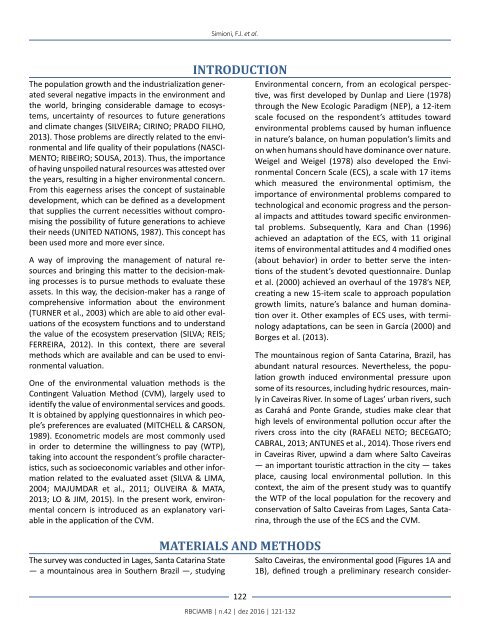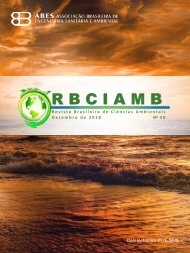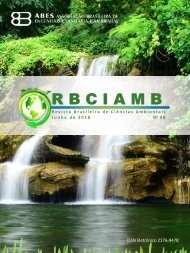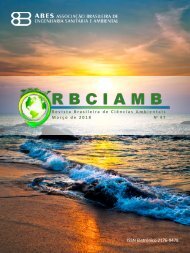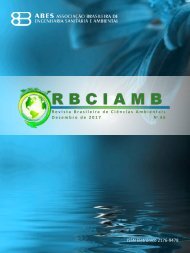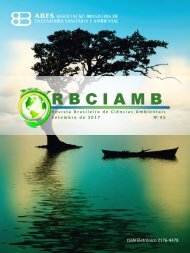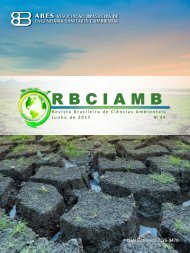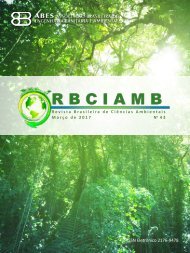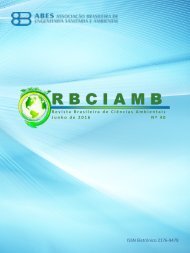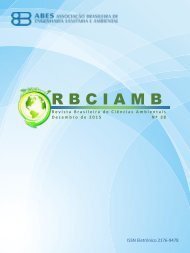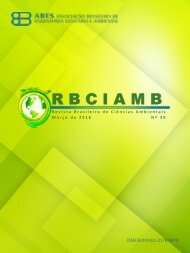EDIÇÃO 42 RBCIAMB
You also want an ePaper? Increase the reach of your titles
YUMPU automatically turns print PDFs into web optimized ePapers that Google loves.
Simioni, F.J. et al.<br />
The population growth and the industrialization generated<br />
several negative impacts in the environment and<br />
the world, bringing considerable damage to ecosystems,<br />
uncertainty of resources to future generations<br />
and climate changes (SILVEIRA; CIRINO; PRADO FILHO,<br />
2013). Those problems are directly related to the environmental<br />
and life quality of their populations (NASCI-<br />
MENTO; RIBEIRO; SOUSA, 2013). Thus, the importance<br />
of having unspoiled natural resources was attested over<br />
the years, resulting in a higher environmental concern.<br />
From this eagerness arises the concept of sustainable<br />
development, which can be defined as a development<br />
that supplies the current necessities without compromising<br />
the possibility of future generations to achieve<br />
their needs (UNITED NATIONS, 1987). This concept has<br />
been used more and more ever since.<br />
A way of improving the management of natural resources<br />
and bringing this matter to the decision-making<br />
processes is to pursue methods to evaluate these<br />
assets. In this way, the decision-maker has a range of<br />
comprehensive information about the environment<br />
(TURNER et al., 2003) which are able to aid other evaluations<br />
of the ecosystem functions and to understand<br />
the value of the ecosystem preservation (SILVA; REIS;<br />
FERREIRA, 2012). In this context, there are several<br />
methods which are available and can be used to environmental<br />
valuation.<br />
One of the environmental valuation methods is the<br />
Contingent Valuation Method (CVM), largely used to<br />
identify the value of environmental services and goods.<br />
It is obtained by applying questionnaires in which people’s<br />
preferences are evaluated (MITCHELL & CARSON,<br />
1989). Econometric models are most commonly used<br />
in order to determine the willingness to pay (WTP),<br />
taking into account the respondent’s profile characteristics,<br />
such as socioeconomic variables and other information<br />
related to the evaluated asset (SILVA & LIMA,<br />
2004; MAJUMDAR et al., 2011; OLIVEIRA & MATA,<br />
2013; LO & JIM, 2015). In the present work, environmental<br />
concern is introduced as an explanatory variable<br />
in the application of the CVM.<br />
The survey was conducted in Lages, Santa Catarina State<br />
— a mountainous area in Southern Brazil —, studying<br />
INTRODUCTION<br />
MATERIALS AND METHODS<br />
Environmental concern, from an ecological perspective,<br />
was first developed by Dunlap and Liere (1978)<br />
through the New Ecologic Paradigm (NEP), a 12-item<br />
scale focused on the respondent’s attitudes toward<br />
environmental problems caused by human influence<br />
in nature’s balance, on human population’s limits and<br />
on when humans should have dominance over nature.<br />
Weigel and Weigel (1978) also developed the Environmental<br />
Concern Scale (ECS), a scale with 17 items<br />
which measured the environmental optimism, the<br />
importance of environmental problems compared to<br />
technological and economic progress and the personal<br />
impacts and attitudes toward specific environmental<br />
problems. Subsequently, Kara and Chan (1996)<br />
achieved an adaptation of the ECS, with 11 original<br />
items of environmental attitudes and 4 modified ones<br />
(about behavior) in order to better serve the intentions<br />
of the student’s devoted questionnaire. Dunlap<br />
et al. (2000) achieved an overhaul of the 1978’s NEP,<br />
creating a new 15-item scale to approach population<br />
growth limits, nature’s balance and human domination<br />
over it. Other examples of ECS uses, with terminology<br />
adaptations, can be seen in García (2000) and<br />
Borges et al. (2013).<br />
The mountainous region of Santa Catarina, Brazil, has<br />
abundant natural resources. Nevertheless, the population<br />
growth induced environmental pressure upon<br />
some of its resources, including hydric resources, mainly<br />
in Caveiras River. In some of Lages’ urban rivers, such<br />
as Carahá and Ponte Grande, studies make clear that<br />
high levels of environmental pollution occur after the<br />
rivers cross into the city (RAFAELI NETO; BECEGATO;<br />
CABRAL, 2013; ANTUNES et al., 2014). Those rivers end<br />
in Caveiras River, upwind a dam where Salto Caveiras<br />
— an important touristic attraction in the city — takes<br />
place, causing local environmental pollution. In this<br />
context, the aim of the present study was to quantify<br />
the WTP of the local population for the recovery and<br />
conservation of Salto Caveiras from Lages, Santa Catarina,<br />
through the use of the ECS and the CVM.<br />
Salto Caveiras, the environmental good (Figures 1A and<br />
1B), defined trough a preliminary research consider-<br />
122<br />
<strong>RBCIAMB</strong> | n.<strong>42</strong> | dez 2016 | 121-132


